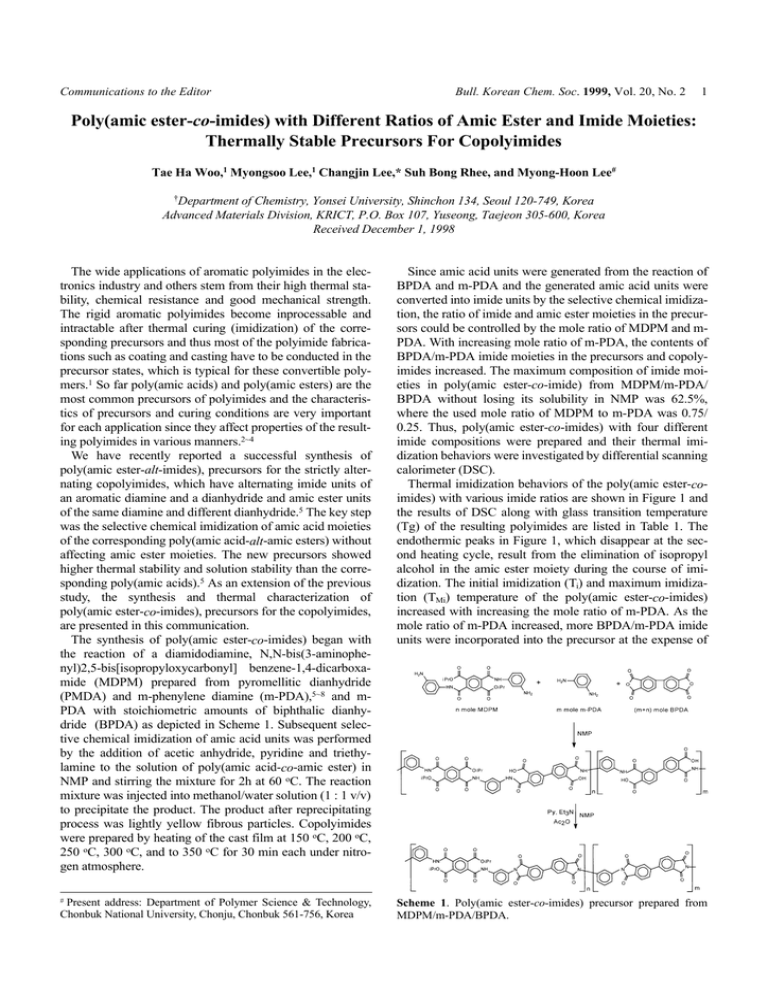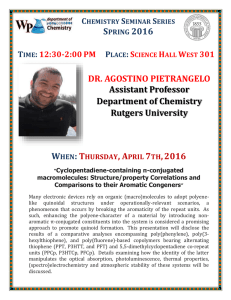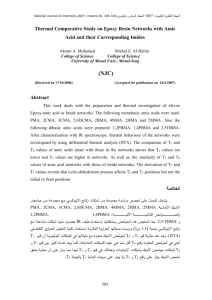Poly(amic ester-co-imides) with Different Ratios of Amic Ester and
advertisement

Communications to the Editor Bull. Korean Chem. Soc. 1999, Vol. 20, No. 2 1 Poly(amic ester-co-imides) with Different Ratios of Amic Ester and Imide Moieties: Thermally Stable Precursors For Copolyimides Tae Ha Woo,1 Myongsoo Lee,1 Changjin Lee,* Suh Bong Rhee, and Myong-Hoon Lee# †Department of Chemistry, Yonsei University, Shinchon 134, Seoul 120-749, Korea Advanced Materials Division, KRICT, P.O. Box 107, Yuseong, Taejeon 305-600, Korea Received December 1, 1998 The wide applications of aromatic polyimides in the electronics industry and others stem from their high thermal stability, chemical resistance and good mechanical strength. The rigid aromatic polyimides become inprocessable and intractable after thermal curing (imidization) of the corresponding precursors and thus most of the polyimide fabrications such as coating and casting have to be conducted in the precursor states, which is typical for these convertible polymers.1 So far poly(amic acids) and poly(amic esters) are the most common precursors of polyimides and the characteristics of precursors and curing conditions are very important for each application since they affect properties of the resulting polyimides in various manners.2~4 We have recently reported a successful synthesis of poly(amic ester-alt-imides), precursors for the strictly alternating copolyimides, which have alternating imide units of an aromatic diamine and a dianhydride and amic ester units of the same diamine and different dianhydride.5 The key step was the selective chemical imidization of amic acid moieties of the corresponding poly(amic acid-alt-amic esters) without affecting amic ester moieties. The new precursors showed higher thermal stability and solution stability than the corresponding poly(amic acids).5 As an extension of the previous study, the synthesis and thermal characterization of poly(amic ester-co-imides), precursors for the copolyimides, are presented in this communication. The synthesis of poly(amic ester-co-imides) began with the reaction of a diamidodiamine, N,N-bis(3-aminophenyl)2,5-bis[isopropyloxycarbonyl] benzene-1,4-dicarboxamide (MDPM) prepared from pyromellitic dianhydride (PMDA) and m-phenylene diamine (m-PDA),5~8 and mPDA with stoichiometric amounts of biphthalic dianhydride (BPDA) as depicted in Scheme 1. Subsequent selective chemical imidization of amic acid units was performed by the addition of acetic anhydride, pyridine and triethylamine to the solution of poly(amic acid-co-amic ester) in NMP and stirring the mixture for 2h at 60 oC. The reaction mixture was injected into methanol/water solution (1 : 1 v/v) to precipitate the product. The product after reprecipitating process was lightly yellow fibrous particles. Copolyimides were prepared by heating of the cast film at 150 oC, 200 oC, 250 oC, 300 oC, and to 350 oC for 30 min each under nitrogen atmosphere. Since amic acid units were generated from the reaction of BPDA and m-PDA and the generated amic acid units were converted into imide units by the selective chemical imidization, the ratio of imide and amic ester moieties in the precursors could be controlled by the mole ratio of MDPM and mPDA. With increasing mole ratio of m-PDA, the contents of BPDA/m-PDA imide moieties in the precursors and copolyimides increased. The maximum composition of imide moieties in poly(amic ester-co-imide) from MDPM/m-PDA/ BPDA without losing its solubility in NMP was 62.5%, where the used mole ratio of MDPM to m-PDA was 0.75/ 0.25. Thus, poly(amic ester-co-imides) with four different imide compositions were prepared and their thermal imidization behaviors were investigated by differential scanning calorimeter (DSC). Thermal imidization behaviors of the poly(amic ester-coimides) with various imide ratios are shown in Figure 1 and the results of DSC along with glass transition temperature (Tg) of the resulting polyimides are listed in Table 1. The endothermic peaks in Figure 1, which disappear at the second heating cycle, result from the elimination of isopropyl alcohol in the amic ester moiety during the course of imidization. The initial imidization (Ti) and maximum imidization (TMi) temperature of the poly(amic ester-co-imides) increased with increasing the mole ratio of m-PDA. As the mole ratio of m-PDA increased, more BPDA/m-PDA imide units were incorporated into the precursor at the expense of # Scheme 1. Poly(amic ester-co-imides) precursor prepared from MDPM/m-PDA/BPDA. Present address: Department of Polymer Science & Technology, Chonbuk National University, Chonju, Chonbuk 561-756, Korea 2 Bull. Korean Chem. Soc. 1999, Vol. 20, No. 2 Communications to the Editor Table 1. Thermal properties of MDPM/m-PDA/BPDA poly(amic ester-co-imides) and copolyimides BPDA/m-PDA imide moiety content (%) 50 MDPM/m-PDA (n/m) 57.5 60 62.5 1/0 0.85/0.15 0.8/0.2 0.75/0.25 Ti (oC) 248 249 252 255 TMi (oC) 278 283 290 303 Tg of PI (oC) 373 371 367 364 60a 100b 0/1 393 360 a Copolyimide prepared from PMDA/BPDA/m-PDA (mole ratio; 4 : 5 : 9). b Homopolyimide prepared from BPDA/m-PDA. Figure 1. DSC thermograms of the poly(amic ester-co-imides) from MDPM/m-PDA/BPDA with different imide contents. PMDA/m-PDA amic ester units. This resulted in the increase of the precursor rigidity since BPDA/m-PDA imide units can be regarded more rigid than PMDA/m-PDA amic ester units. The more rigid BPDA/m-PDA imide units were incorporated into the precursor polymer, the more energy was needed to form imide rings from amic ester units, which resulted in the increase of Ti and TMi. Similar phenomena have been observed by Kim et al.9 during the isothermal imidization of poly(p-phenylene biphenyltetracarboxamic diethyl etster) (BPDA/p-PDA ES). It was found that the imidization of poly(amic dialkyl esters) was proceeded with the fast first step followed by the slow second step. It was proposed that the imidization rate slowed down above certain imidization degree because the rigidity of precursor polymer increased as the imidization proceeded,9 which is consistent with the present study. Meanwhile, Tg’s of the resulting copolyimides decreased as the ratio of PMDA/m-PDA amic ester contents in poly(amic ester-co-imides) precursor decreased. (Table 1) Increasing mole fraction of m-PDA resulted in the decrease of PMDA/m-PDA imide contents vs BPDA/m-PDA imide contents in the copolyimides. Before curing, PMDA/m-PDA units existed as amic ester in the precursors and after curing, PMDA/m-PDA units existed as imide in copolyimides. Thus, the decrease of PMDA/m-PDA imide contents in the resulting copolyimides is expected to lower Tg of copolyimides because Tg of PMDA/m-PDA is higher than that of BPDA/m-PDA homopolyimide (360 oC). It is also interesting to note that Tg (393 oC) of the copolyimide, which was prepared by mixing all three monomers together (PMDA/BPDA/mPDA; mole ratio 0.4 : 0.5 : 1), was found to be higher than Tg (367 oC) of the copolyimide prepared from MDPM/BPDA/m-PDA (mole ratio 0.8 : 1 : 0.2). Considering that the compositions of PMDA/ m-PDA and BPDA/m-PDA imide units in both copolyimides were the same, the difference of Tg was significant. The difference in these two copolyimides was the employed precursors, where poly(amic acid) was the precursor in case of mixing monomers and poly(amic ester-co-imide) was the precursor in case of using MDPM. But it seems less likely that the difference in Tg was due to the employed precursors because it has been reported that Tg of polyimides are not much affected whether they are prepared from poly(amic acids) or poly(amic esters).10 Instead we assumed that PMDA/m-PDA imide block segments may be produced in the copolyimide prepared directly from PMDA/BPDA/mPDA, which resulted in the increase of Tg. Although block copolyimides are difficult to obtain by simple mixing of the monomers,11 the higher reactivity of PMDA than BPDA may allow to form partial block PMDA/m-PDA imide segments in the copolyimide. There were no block segment of PMDA/m-PDA imide in the copolyimides prepared by the present method because PMDA/m-PDA imide units were always located next to at least one or more BPDA/m-PDA imide units. In summary, a successful synthesis of poly(amic ester-coimides), new types of copolyimide precursors, were presented. The synthetic methodology reported here can provide the preparation of various copolyimide precursors stable at high temperature, which can be utilized to the synthesis of a broad range of copolyimides with fine control of molecular structure. Acknowledgement. It is gratefully acknowledged that this work has been supported by the Ministry of Science and Technology of Korea and LG Chem. Ltd. References 1. Sroog, C. E. In Polyimides; Ghosh, M. K.; Mittal, K. L.; Eds.; Marcel Dekker, Inc.: New York, U. S. A., 1996; p 187. 2. Kreuz, J. A.; Endrey, A. L.; Gay, F. P.; Sroog, C. E. J. Polym. Sci. Part A-1 1966, 4, 2607. 3. Becker, K. H.; Schmidt, H. W. Macromolecules 1992, 25, 6784. 4. Miwa, T.; Okabe, Y.; Ishida, M. Polymer 1997, 38, 4945. 5. Lee, M. H.; Park, J. W.; Rhee, S. B. Macromol. Symp. 1997, 118, 177. 6. Rhee, S. B.; Park, J. W.; Moon, B. S.; Chang, J. Y. Macromolecules 1993, 26, 404. Communications to the Editor 7. Park, J. W.; Lee, M.; Lee, M. H.; Liu, J. W.; Kim, S. D.; Chang, J. Y.; Rhee, S. B. Macromolecules 1994, 27, 3459. 8. Rhee, S. B.; Park, J. W.; Moon, B. S.; Lee, M. H.; Chang, J. Y. Macromol. Chem. Phys. 1995, 196, 691. 9. Kim, K.; Ryou, J. H.; Kim, Y.; Ree, M.; Chang, T. Polymer Bulletin 1995, 219. Bull. Korean Chem. Soc. 1999, Vol. 20, No. 2 3 10. Goeschel, U.; Lee, H.; Yoon, D. Y.; Siemens, R. L.; Smith, B. A.; Volksen, W. Colloid Polym. Sci. 1994, 272, 1388. 11. Coburn, J. C.; Pottiger, M. T. In Polyimides; Ghosh, M. K., Mittal, K. L., Eds.; Marcel Dekker, Inc.: New York, U. S. A., 1996; p 236.





